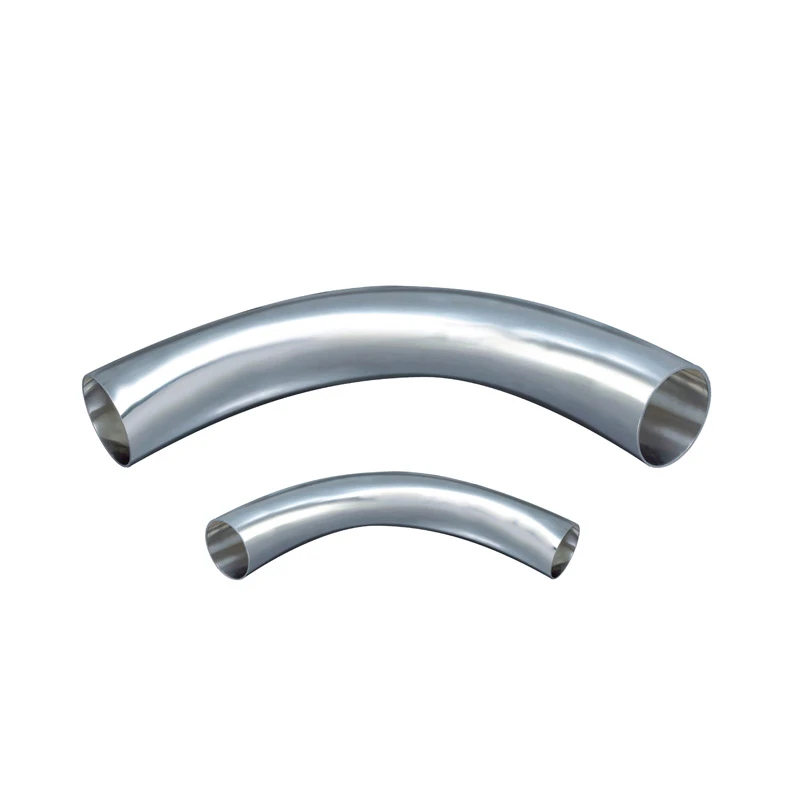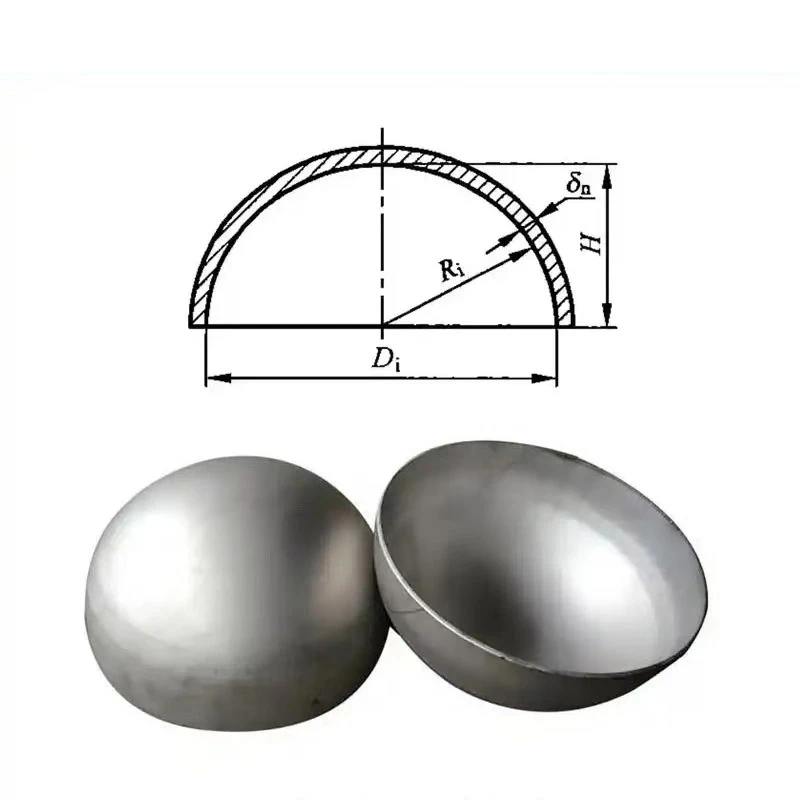Elbow Classification
- By Material: Carbon steel, alloy steel, stainless steel, and low-temperature steel.
- By Radius: Long-radius elbows and short-radius elbows.
- By Forming Method: Hot pushing, hot pressing, cold pushing, and plate pressing.
Elbows primarily adhere to international standards such as ASME B16.9-2018 and MSS SP-75-2019.
Elbow Features
1.Diverse Specifications and Models: Elbows come in various specifications and models to meet the needs of different piping systems.
2.Flexibility: Elbows can change pipeline direction by connecting at different angles.
3.Long Service Life: With proper design and usage, elbows have a long service life. High-quality materials and advanced manufacturing processes ensure that elbows maintain good performance over time, reducing pipeline system failures caused by elbow damage and enhancing system reliability and stability.
Bimetal CLAD Elbow
Bimetal Clad elbow is a kind of pipe fitting which is composed of two different metal materials through a specific process.
Structure clad of Bimetal clad elbow
Outer layer: ordinary carbon steel or other high-strength metal materials, such as 16MnR steel, are generally used, and their main functions are to provide structural strength and toughness, so that the elbow can withstand external forces such as pressure, tension and bending moment in the pipeline system and ensure stability under high pressure and high load conditions.
Inner layer: metal materials with good wear resistance and corrosion resistance are usually selected, such as high chromium cast iron, KMTBCr28 and other alloy materials. These materials have high hardness and can effectively resist the erosion, wear and corrosion of materials and chemical media.
Performance characteristics
High wear resistance: the hardness of the wear-resistant alloy material in the inner layer can usually reach HRC46 or above. For example, the hard phase of high chromium cast iron KMTBCr28 is M7C3 carbide, and the hardness reaches HV1500-1800, which can greatly reduce the wear on the inner wall of the elbow during material transportation and prolong the service life of the elbow.
Good impact resistance: the high-strength metal in the outer layer provides good toughness, while the wear-resistant alloy in the inner layer has certain toughness while ensuring hardness, so that the Bimetal Composite elbow can withstand external forces such as the impact of materials and the vibration in the operation of the pipeline system.
Excellent corrosion resistance: the corrosion-resistant alloy in the inner layer can effectively resist the corrosion of various chemicals, and is suitable for conveying corrosive media such as acid, alkali and salt.
Good heat resistance: the matrix of superhard alloy material has strong heat resistance and can maintain stable performance in high temperature environment, which can be used for conveying pipes of high temperature materials.
Reliable bonding performance: through advanced composite technology, such as EPC vacuum suction casting composite technology, the inner and outer layers of metals are metallurgically bonded, and the bonding surface has high strength, and there will be no expansion, contraction and cracking.
Elbow weight
The formula for calculating the weight of a 90° elbow is:
W=9.685×10-6R(D2-d2)
W — Weight of the 90°elbow, kg;
R — Curvature radius of the elbow (structural dimension), mm;
D — Outer diameter of the elbow, mm;
d — Inner diameter of the elbow, mm.
The weight formula uses the density of carbon steel, which is 7.85 kg/dm³.
The weights of 45° and 180° elbows are calculated as half and twice the weight of a 90° elbow, respectively.
1)Butt weld 90° long radius elbow
|
Nominal Diameter
|
Approx weight kg
|
|
DN
|
NPS
|
SCH10S
|
SCH20
|
STD
|
SCH40
|
XS
|
SCH80
|
|
15
|
1/2
|
0.06
|
-
|
0.08
|
0.08
|
0.10
|
0.10
|
|
20
|
3/4
|
0.08
|
-
|
0.11
|
0.11
|
0.13
|
0.13
|
|
25
|
1
|
0.13
|
-
|
0.15
|
0.15
|
0.21
|
0.21
|
|
32
|
1-1/4
|
0.21
|
-
|
0.25
|
0.25
|
0.36
|
0.36
|
|
40
|
1-1/2
|
0.28
|
-
|
0.39
|
0.39
|
0.52
|
0.52
|
|
50
|
2
|
0.47
|
-
|
0.66
|
0.66
|
0.96
|
0.96
|
|
65
|
2-1/2
|
0.79
|
-
|
1.37
|
1.37
|
1.80
|
1.80
|
|
80
|
3
|
1.16
|
-
|
2.19
|
2.19
|
2.87
|
2.87
|
|
90
|
3-1/2
|
1.55
|
-
|
2.96
|
2.96
|
4.06
|
4.06
|
|
100
|
4
|
2.02
|
-
|
4.13
|
4.13
|
5.60
|
5.60
|
|
125
|
5
|
3.46
|
-
|
6.89
|
6.89
|
9.62
|
9.62
|
|
150
|
6
|
4.98
|
-
|
10.7
|
10.7
|
16.5
|
16.5
|
|
200
|
8
|
9.57
|
16.5
|
21.6
|
21.6
|
31.6
|
31.6
|
|
250
|
10
|
16.7
|
25.8
|
37.0
|
37.0
|
49.9
|
60.7
|
|
300
|
12
|
25.9
|
36.1
|
56.0
|
61.0
|
71.6
|
97.4
|
|
350
|
14
|
34.7
|
60.2
|
71.4
|
85.1
|
92.0
|
139
|
|
400
|
16
|
45.4
|
78.0
|
93.6
|
121
|
121
|
200
|
|
450
|
18
|
56.2
|
87.7
|
119
|
176
|
153
|
287
|
|
500
|
20
|
82.2
|
147
|
147
|
232
|
190
|
396
|
|
550
|
22
|
99.6
|
178
|
178
|
-
|
230
|
515
|
|
600
|
24
|
136
|
212
|
212
|
377
|
275
|
635
|
|
650
|
26
|
-
|
323
|
249
|
-
|
323
|
-
|
|
700
|
28
|
-
|
375
|
290
|
-
|
375
|
-
|
|
750
|
30
|
265
|
431
|
333
|
-
|
431
|
-
|
|
800
|
32
|
-
|
491
|
379
|
675
|
491
|
-
|
|
850
|
34
|
-
|
555
|
428
|
762
|
555
|
-
|
|
900
|
36
|
-
|
622
|
480
|
950
|
622
|
-
|
|
950
|
38
|
-
|
-
|
535
|
-
|
694
|
-
|
|
1000
|
40
|
-
|
-
|
594
|
-
|
769
|
-
|
|
1050
|
42
|
-
|
-
|
655
|
-
|
849
|
-
|
|
1100
|
44
|
-
|
-
|
718
|
-
|
932
|
-
|
|
1150
|
46
|
-
|
-
|
786
|
-
|
1019
|
-
|
|
1200
|
48
|
-
|
-
|
865
|
-
|
1110
|
-
|
|
1300
|
52
|
-
|
-
|
1006
|
-
|
-
|
-
|
|
1400
|
56
|
-
|
-
|
1183
|
-
|
-
|
-
|
|
1500
|
60
|
-
|
-
|
1341
|
-
|
-
|
-
|
|
1600
|
64
|
-
|
-
|
1526
|
-
|
-
|
-
|
|
1700
|
68
|
-
|
-
|
1723
|
-
|
-
|
-
|
|
1800
|
72
|
-
|
-
|
1933
|
-
|
-
|
-
|
|
1900
|
76
|
-
|
-
|
2154
|
-
|
-
|
-
|
|
2000
|
80
|
-
|
-
|
2388
|
-
|
-
|
-
|
2)Butt weld 90° short radius elbow
|
Nominal Diameter
|
Approx weight kg
|
|
DN
|
NPS
|
SCH10S
|
SCH20
|
STD
|
SCH40
|
XS
|
SCH80
|
|
25
|
1
|
0.08
|
-
|
0.11
|
0.11
|
0.13
|
0.13
|
|
32
|
1-1/4
|
0.14
|
-
|
0.17
|
0.17
|
0.24
|
0.24
|
|
40
|
1-1/2
|
0.19
|
-
|
0.24
|
0.24
|
0.34
|
0.34
|
|
50
|
2
|
0.32
|
-
|
0.44
|
0.44
|
0.68
|
0.68
|
|
65
|
2-1/2
|
0.53
|
-
|
0.91
|
0.91
|
1.18
|
1.18
|
|
80
|
3
|
0.78
|
-
|
1.36
|
1.36
|
1.91
|
1.91
|
|
90
|
3-1/2
|
1.04
|
-
|
1.96
|
1.96
|
2.58
|
2.58
|
|
100
|
4
|
1.35
|
-
|
2.77
|
2.77
|
3.54
|
3.54
|
|
125
|
5
|
2.32
|
-
|
4.40
|
4.40
|
6.46
|
6.46
|
|
150
|
6
|
3.31
|
-
|
7.12
|
7.12
|
10.6
|
10.6
|
|
200
|
8
|
6.38
|
11.0
|
14.1
|
14.1
|
21.1
|
21.1
|
|
250
|
10
|
11.2
|
16.8
|
24.6
|
24.6
|
33.2
|
40.4
|
|
300
|
12
|
17.3
|
24.1
|
37.0
|
40.6
|
47.7
|
65.0
|
|
350
|
14
|
23.2
|
40.2
|
42.6
|
54.5
|
61.3
|
92.4
|
|
400
|
16
|
30.2
|
51.9
|
62.2
|
80.4
|
80.4
|
133
|
|
450
|
18
|
38.3
|
65.7
|
79.1
|
117
|
102
|
184
|
|
500
|
20
|
54.9
|
97.9
|
97.9
|
155
|
126
|
255
|
|
550
|
22
|
66.5
|
119
|
119
|
-
|
154
|
333
|
|
600
|
24
|
90.6
|
142
|
142
|
251
|
183
|
424
|
|
650
|
26
|
-
|
-
|
167
|
-
|
-
|
-
|
|
700
|
28
|
-
|
-
|
194
|
-
|
-
|
-
|
|
750
|
30
|
-
|
-
|
222
|
-
|
-
|
-
|
|
800
|
32
|
-
|
-
|
253
|
438
|
-
|
-
|
|
850
|
34
|
-
|
-
|
286
|
495
|
-
|
-
|
|
900
|
36
|
-
|
-
|
320
|
607
|
-
|
-
|
|
950
|
38
|
-
|
-
|
357
|
-
|
-
|
-
|
|
1000
|
40
|
-
|
-
|
396
|
-
|
-
|
-
|
|
1050
|
42
|
-
|
-
|
437
|
-
|
-
|
-
|
|
1100
|
44
|
-
|
-
|
480
|
-
|
-
|
-
|
|
1150
|
46
|
-
|
-
|
524
|
-
|
-
|
-
|
|
1200
|
48
|
-
|
-
|
571
|
-
|
-
|
-
|
|
1300
|
52
|
-
|
-
|
671
|
-
|
-
|
-
|
|
1400
|
56
|
-
|
-
|
776
|
-
|
-
|
-
|
|
1500
|
60
|
-
|
-
|
894
|
-
|
-
|
-
|
|
1600
|
64
|
-
|
-
|
1010
|
-
|
-
|
-
|
|
1700
|
68
|
-
|
-
|
1149
|
-
|
-
|
-
|
|
1800
|
72
|
-
|
-
|
1289
|
-
|
-
|
-
|
|
1900
|
76
|
-
|
-
|
1436
|
-
|
-
|
-
|
|
2000
|
80
|
-
|
-
|
1592
|
-
|
-
|
-
|


